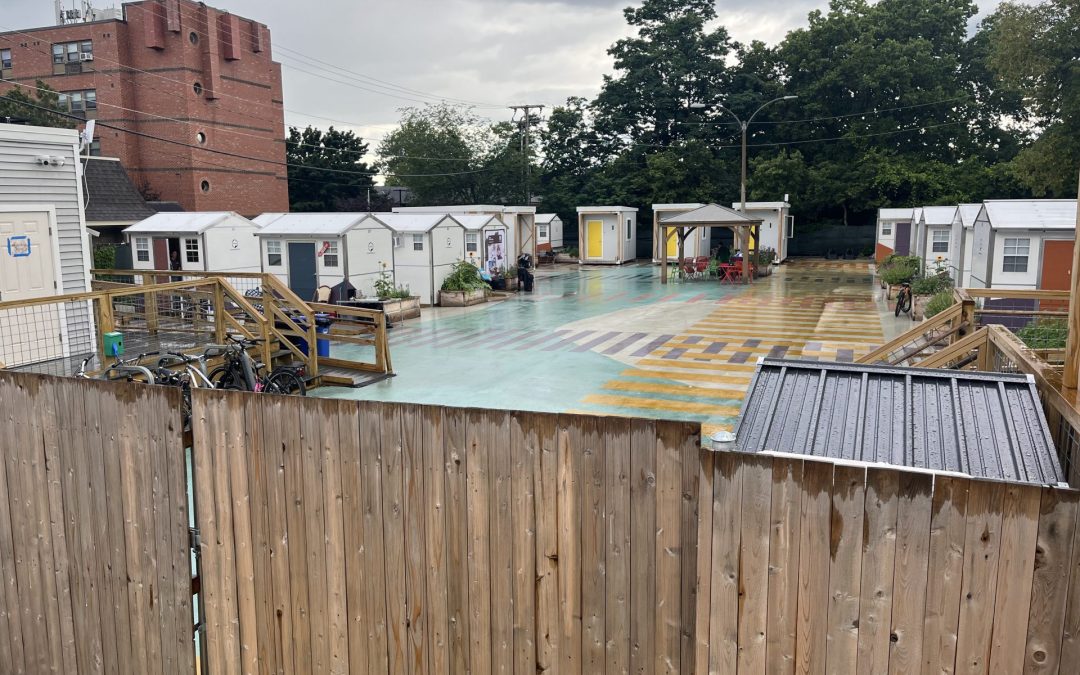The Elmwood Emergency Shelter Community, which opened in February, accommodates up to 35 adults in small, modular structures on a former parking lot just outside downtown Burlington. Getting the project off the ground wasn’t easy, according to city officials, who, in June, discussed some of the challenges of development and operations with the Montpelier Homelessness Task Force.
The City of Montpelier created the Task Force in 2019. Chaired by Another Way Executive Director Ken Russell, it also includes Vermont Psychiatric Survivors Vice President Zack Hughes. At the time of the City of Burlington’s public presentation at the Kellogg-Hubbard Library, it hadn’t identified a potential site or funding source for a pod-based shelter in Montpelier.
The first of its kind in Vermont, Burlington’s 30-unit Elmwood facility makes use of flat-packed, rapidly assembled pods, manufactured primarily by the Washington-based company Pallet. By its own count, Pallet has, across the country, produced more than 100 “transitional shelter villages” since 2016.
Burlington’s commitment to building one of its own emerged out of the controversy around its 2021 decision to shut down the unsanctioned Sears Lane encampment in the city’s South End, in the telling of Assistant Director for Community Works Samantha Dunn.
“People felt like that was a community that they had in place,” Dunn said. “We were able to get them into shelter, but it was recognized that there was a need for additional shelter within the City of Burlington.”
That year, in December, Mayor Miro Weinberger publicized a 10-point “action plan” to address homelessness, which proposed an investment in “approximately 30 shelter pods and related infrastructure to create a new low-barrier facility for 2022.” The City Council approved funding the following February. Opening day didn’t arrive during the calendar year as planned, but it came close.
Burlington’s federal stimulus from the American Rescue Plan Act covered most of the $1.821 million price of development. The 64-square-foot pods themselves – which have electricity, heat, and air conditioning, but not running water – cost $414,778 in total, including five relatively deluxe, custom-made units from Up End This in Johnson, Vermont.
Another $362,731 brought two larger prefabricated buildings to the site. One operates as a community center with a laundry room and a dining room; the other houses six full bathrooms.
Sewer and water connections and electrical trenching for the city-owned site cost $190,563. The Vermont Agency of Natural Resources chipped in $61,750 for the removal of an underground petroleum tank, but the total expense of the job doubled that figure.
Residents can stay for up to 180 days. Dunn hypothesized that, if necessary, staff could allow a resident to circumvent the limit by transferring them to a new pod, which would, theoretically, qualify as a new stay.
The emergency shelter will occupy the lot on Elmwood Avenue for three years. The pods themselves have a much longer usable life, and Dunn expects Burlington to find ways to repurpose them once the shelter has closed.
Dunn characterized the facility’s temporariness as “part of a permitting strategy, quite honestly. It was political.”
So, too, was its size: the half-acre site could have accommodated more than 35 placements, a number that Dunn “would have increased” if not for the imperative to win (and hold onto) discretionary approvals from bodies like Burlington’s Development Review Board and Public Works Commission.
“We spent a lot of time having community meetings,” Dunn said. “We had contentious DRB hearings. And the amount of time required to sort of get the community comfortable enough not to appeal the permit and just make people understand what it was going to be like – that was a very important thing to consider when you’re thinking about the site.”
The shelter’s permit requires 24/7/365 staffing, including two overnight security guards, who account for $417,305 of the $1,368,757 annual operating budget. During the daytime, the Champlain Housing Trust operates the facility, which, without a commercial kitchen (or, for that matter, a kitchen for the residents’ use), serves three meals daily, premade and delivered by Feeding Chittenden.
By Dunn’s calculation, the operational costs break down, on a per-person basis, to the equivalent of “a motel night” by way of the pandemic-era General Assistance Emergency Housing Program. In this case, it includes services. Per Dunn, the state foots “the majority” of the bill.
“It’s much more expensive than we were anticipating,” she acknowledged. “The city had a very challenging time trying to get someone to operate the site, and there was a very uncomfortable meeting between the city and the state.”
“The state really wanted to see how does this model work,” she continued. “There was a lot of pressure put on the Champlain Housing Trust to step into this role, and they have kind of said, ‘This is what it costs for us to do it.’ And they’re doing a phenomenal job.”
In Dunn’s view, the privacy of shelter pods offers an alternative to congregate shelters. At the Kellogg-Hubbard Library, a member of the audience noted that, during their own period of homelessness, they’d tried to avoid the latter, where the constant presence of strangers “would drive any sane person batty, if not insane,” as they put it.
At the same time, the Elmwood shelter aims to create a sense of community. A $9,900 “placemaking” grant from the Vermont Community Foundation has helped make the built environment a little friendlier.
Burlington-based artist Liza Philip designed custom murals for the site. “She’s starting them, and then some of the guests at the site are going to help finish them,” Dunn explained.
The city has also installed garden beds, but in June, residents hadn’t yet stepped forward to tend them.
“I’m going to buy the plants tomorrow,” Dunn said. “The site manager put up a sign to start a garden club. She said no one came. So when I was on site, I had to line all these things with fabric, and we moved the dirt. I think people will [come]. We just need to get the stuff there.”
A person in the crowd asked Dunn whether, in planning the facility, Burlington had involved “people with lived experience” at “every step in the process.”
Dunn replied that the city had solicited input during the development of the operations policy and in the site design, leading to modifications in, for example, the alignment of the pods’ front doors. But she declined to affirm start-to-finish participation, seemingly indicating that homeless Burlingtonians may not have weighed in on the decision to pursue the project in the first place.
Dunn’s slides included a list of “lessons learned” for other cities that might want to build a pod-based emergency shelter. The first one was: “You can do it!”
“It was a little bit of luck that I was hired. My workload hadn’t been determined, and I had development experience,” Dunn recollected. “I think you could hire a consultant, but someone’s really got to drive it. It’s not going to build itself.”
Until the first severe cold spell, she’d worried that the pods, which have little insulation, wouldn’t always stay warm. But the electric heaters proved powerful enough, without unmanageable energy bills.
Slides from a colleague, Special Assistant to End Homelessness Sarah Russell, encouraged future shelter operators to adopt some of the policies that seemed to have helped in Burlington, like allowing couples to stay together in a single pod, permitting pets, and encouraging residents to accept case management but not mandating it.
As of June 30, according to city data, the Elmwood Emergency Shelter Community had sheltered 49 people, connecting 43 of them to case management via the Champlain Valley Office of Economic Opportunity.
Thirteen had exited the shelter involuntarily. Two had exited to permanent housing.

